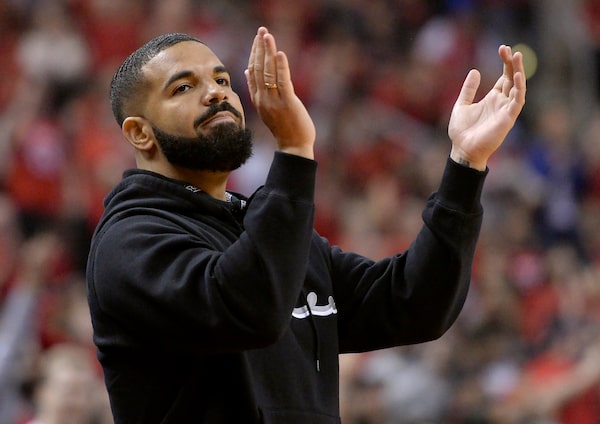
Aubrey 'Drake' Graham cheers from courtside during first half NBA Eastern Conference finals action between the Toronto Raptors and the Milwaukee Bucks, in Toronto on May 25, 2019. The Toronto Raptors’ global ambassador does something special, especially for a city that lives in the shadow of U.S. media industries.Nathan Denette/The Canadian Press
The thunderous roar of Jurassic Park, as Torontonians cheer on Canada’s only professional basketball team, the Raptors, has not been outdone by the gripings and criticisms of opposing teams whose disdain for Drake grows each series.
His enthusiasm, his trash talking – in short, his passionate expressiveness – have rubbed many the wrong way; according to some, this hip-hop star has gone too far. But hip hop and basketball have a lengthy, intertwined relationship dating back to 1992.
When Chris Webber, a 6-foot-9 power forward, leapt atop the scorer’s table to celebrate another comeback win for his team, the Michigan Wolverines, a unique relationship between basketball and hip hop began to emerge. His arms began to sway from side to side, as the loudspeaker boomed Naughty by Nature’s Hip Hop Hooray. Today, NBA arenas regularly feature hip-hop songs, but 27 years ago, Mr. Webber’s celebrations to a hip-hop song were frowned upon. Later, ESPN called the Michigan Wolverines’ 1991 freshman class, dubbed the Fab Five, the most culturally influential college basketball team of its era, and they brought hip-hop culture to millions of American teens watching college basketball.
Cameras were constantly in their faces and today, as I rewatch the clips, I wonder if the media were simply mystified by the confidence of these young black men – their unwavering swagger. Hip-hop culture’s bravado and boisterousness was on full display on national television via a heralded college basketball team. As soon as the Fab Five arrived in Ann Arbor, this top-ranked recruiting class, which included later-to-be Toronto Raptor Jalen Rose, quickly changed the school’s uniform, opting for big and baggy shorts, black shoes, black socks (which were banned in the NBA) and bald shaven heads in honour of Michael Jordan. All five of them brought with them elements of both streetball culture and hip hop to the NCAA’s extensive television coverage for the first time.
They celebrated, they destroyed opponents, they trash talked, they got the fans involved – they were the embodiment of hip hop’s self-confidence. In the early 1990s, hip hop was still a subculture buried deep within urban America, nowhere near topping the billboard charts of today but steadily gaining a wider fan base.
The Fab Five, steeped in modes of black expressive culture, ruffled many feathers with their style of play, which refused to conform to standards of comportment and expressiveness that make comfortable cultural gatekeepers. (Their style was not unlike Dr. J’s legendary play in Harlem’s famed Rucker Park in the 1970s, but now African-American expressive culture was televised nationally with the Fab Five’s winning ways.)
Today, in the NBA finals, Drake belongs right where he is. He is an evolution of the Fab Five’s expressive style and this relationship between hip hop and basketball. The Toronto Raptors’ global ambassador does something special, especially for a city that lives in the shadow of U.S. media industries. Drake’s pride in Toronto demonstrates one of the most significant aspects of hip-hop culture: its hyperlocal concerns and its members’ desire to represent their city.
When cities such as Philadelphia become Philly, when Chicago become the Chi, or when Toronto becomes the T-Dot or the 6ix, hip hop’s expressive renaming practices create a bond, a civic pride that encourages hip-hop fans to love their city. If you pay close attention to Toronto hip-hop videos from the mid-1990s, prominent parts of Toronto became important backdrops in songs such as Choclair’s What it Takes or T-Dot Anthem by IRS.
By 2001, Toronto hip-hop artists were brimming with local pride, none greater than on the remix to the Clipse’s breakthrough song, Grindin, where Toronto’s own Kardinal Offishall opens the track flying the flag: “Mr. Canadian, Mr. Canuck."
Today, the relationship between the NBA and hip-hop culture is so tightly woven that many players, from Chris Webber to Damian Lillard to Lonzo Ball, record their own albums. Or, in the other direction, Jay-Z was a minority owner of the Brooklyn Nets.
And with our local hip-hop artists demonstrating a confident Canadianness, that has become commonplace in this year’s Raptor’s playoff run.
Such is the gift of hip-hop culture, a youthful brashness leading to a level of confidence that has been absorbed by young generations of hip-hop artists, and has now seeped into the Toronto Raptors franchise and their fans. With the arrival of superstar Kawhi Leonard and his quiet confidence, Toronto Raptors fans (many whom might also be hip-hop fans) have vociferously vocalized their growing pride and confidence in this city and in their franchise.
The Toronto we see today on the world stage at the NBA Finals is a city that has absorbed the bold self-confidence embedded in hip-hop culture. So while the Fab Five were derided as showboating, undisciplined streetballers in 1992, their legacy – a hip hop informed self-confidence – continues to infuse hip hop and basketball culture in ways that help cities such as Toronto find itself.